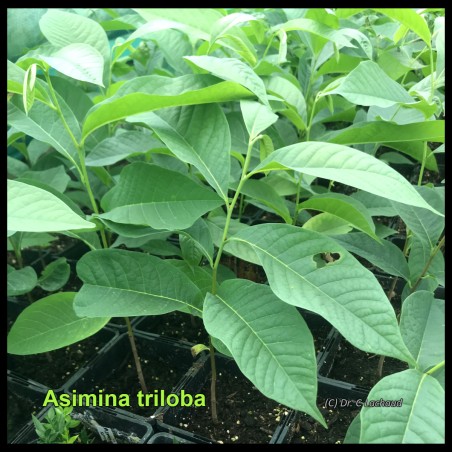











Asimina triloba - Pawpaw
1 Plant Bare Roots
2 years old, not grafted
Seasonal Product
Shipped from October to February
Seasonal Product
Shipped from October to February
-
Asimina triloba is the only representative of the Annonaceae that comes from temperate regions
Very hardy, the Pawpaw can endure temperatures down to -25°C
It is an ornamental and fruit-bearing shrub or small tree, with deciduous foliage
It requires very little care, and is very easy to grow
However, it does not like windy situations, spray, excessive heat and aridity
The Pawpaw has light green, alternate, simple, and slightly drooping leaves, pleasantly aromatic (the whole plant has a resinous smell of turpentine, the whole plant is poisonous)
Leaves are wide and measure 20 to 30cm long
They turn bright yellow in autumn, offering a show as somptuous as that of the Ginkgos
The port is pyramidal in a sunny position, spread out and rounded in the shade
Flowering begins in March-April, before the leaves appear
It is staggered and can end in May
The flowers, solitary, numerous, brown-red to dark wine-red, have 3 petals
They look like big bells, and measure about 5cm
They are eventually followed by green berries resembling small mangoes, and which contain 2 rows of large beans (2 to 4cm long) brown-black
The berries are generally gathered by 2 to 5 on a short peduncle
They grow gradually during the summer until they reach 15-20cm
Their flesh is very nutritious, rich in antioxidants, yellow, with a creamy texture like that of a ripe avocado, sweet, and delicious
Its tropical aromas call to mind those of banana, mango, melon, pear, cherimoya, and pineapple
The Asimines are harvested mature, between the end of August and the beginning of November depending on the variety, when their skin takes on a few yellow highlights, the fruit becomes slightly soft, and a fragrance of tropical fruit appears
Fruit characteristics vary greatly with the genetics of each plant
More than sixty cultivars are listed for fruit production, and new cultivars are constantly being developed to domesticate the species
Some examples of these variations:
-
Pick the Asimines on the Pawpaw-tree, when they begin to ripen (once ripe, Asimines are quickly attacked by birds and the fruit fly, and they fall and get smashed)
Store in the refrigerator at this stage, up to 2-3 weeks
Finish maturing at room temperature for 2-3 days before eating
The shelf life of fully ripe Asimine won't exceed 48 hours
They spoil quickly, darken, and their aromas evolve and become less pleasant: their marketing is therefore difficult, hence their absence from shops
Hence the value of growing Pawpaw-trees in your garden
Asimine is absolutely delicious fresh
Its skin is bitter, inedible
The bean should not be eaten by mistake because it contains toxic alkaloids that cause gastric disorders
PS: The fruit is toxic before maturity
In the event of a large harvest, the pulp can be extracted automatically with a tomato mill, which will automatically remove the inedible parts
The pulp can then be stored in the freezer, or used immediately as an ingredient in various preparations
For example: pies, cakes, crème brûlée, ice cream, smoothies, fermented drinks (beer, lemonade, etc.) and alcoholic drinks (wine, brandy, etc.), sauces and chutneys, jams, uncooked pulp in yoghurts, etc.
Note that cooking eliminates a lot of aromas
-
The Plant is Delivered Bare Roots with All its Fine Root, from a Potted Plant whose Substrate has been Delicately Removed
It is not Ground Plants that have been Pulled Out with Only the Main Roots remaining
It must be Planted upon Receipt, without being left for several hours or days in the open air (roots dry out) or in water (roots rot)
The Recovery Rate of this Plant Format is Identical to that obtained when Repotting any plant (excellent)
Plant during fall and winter
Growth is slow for the first few years, until the plant has finished establishing its root system
Then it becomes quite fast
Asimina triloba needs deep, acidic to neutral, fertile, well-drained soil that remains fresh in dry periods (in the wild, Asimina triloba is often found near moist places in wooded areas)
First fruiting of plants grown from seed = between 4 and 10 years, depending on care and growing conditions
For fruiting, Asimina triloba must:
If you want to establish a Pawpaw orchard, space the plants 3m apart and the rows 5-6m apart
Pruning is not necessary
Just remove the dead branches in winter, and prune the branches that get in the way
Avoid pruning low branches to clear the trunk (naturally bushy growth), this affects the Pawpaw-tree and it will fruit less - the trunk may also crack in winter
You might also like
Payment :
PayPal < 150 €
Check < 850 €
Bank Wire > 149 €
Thank you for your kind understanding